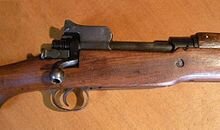- Messages
- 9,364
- Reactions
- 23,647
Just needs Skennerton's Book of the Lee-Enfield downloading, is all.
tac
tac
Follow along with the video below to see how to install our site as a web app on your home screen.
Note: This feature may not be available in some browsers.
British military nomenclature - Short refers to the fact that it's physically SHORT, shorter than the previous Lee-Enfield rifle by about six inches. Magazine means that is has, uh, a magazine. And Lee-Enfield because it's a Lee-Enfield. British military ALWAYS have nicknames for their kit - SMLE easily turns into 'smellie'. 'Brown Bess' mean anything to you? So do US soldiers - the 155mm gun was called 'Long Tom', and the 240mm atomic cannon was called 'Atomic Annie'.........'Warthog', 'Huey', et al.
Now THIS is a genuine British military nomenclature, of an article that could be found in the British Military Psychiatric Hospital in India during the days of the Raj -
Bowl, gutta-percha, handles [without], officers for the use of.
It's a kind of rubbery porridge bowl made so that officers who have gone 'Doolali', - the location of the hospital - could not break it and self-harm.
I bet you ALL wanted to know that one, right?
tac, fullacrap
Well I can't speak to "900 yards" cuz I can't shoot or see at 900 yards. Unless your target is the broad side of a barn. Y'see, I DO know that fired into living breathing tissue at hunting ranges the .303 military does wobble around and tumble- whether its the heavy-base/light tip or some other reason I don't know. 8mm Mauser and LC 7.62 will do the same thing. Based on what "info" Ive seen etc etc, the "pencil-hole in, pencil-hole out" is a myth in these larger calibers. Can't speak to the 5.56/.223 or for that matter the 7.62 combloc. Some of these calibers are hollowDo tell about the tumble thing. Y'see, I shoot a BSA 1918 III* out to 900 yards, and the holes are still round at that distance.
I'm sure I'd have noticed by now.
ta
Well I can't speak to "900 yards" cuz I can't shoot or see at 900 yards. Unless your target is the broad side of a barn. Y'see, I DO know that fired into living breathing tissue at hunting ranges the .303 military does wobble around and tumble-.... Just sayin. Y' see?
Long story shortened ...The model 1914 was built for England as they didn't have the means to do so at the time.Ok, Question time ( not very knowledgeable on British Rifles) We have a Lee-Enfield SMLE, then along comes the Enfield of 1914/17 in good Ol'Merican .30/06 Springfield. Why? Why build another rifle in a non British Standard cal? and Why complicate the whole arms deal by supplying Enfields instead of the 1903 Springfield?
